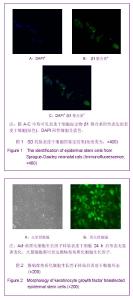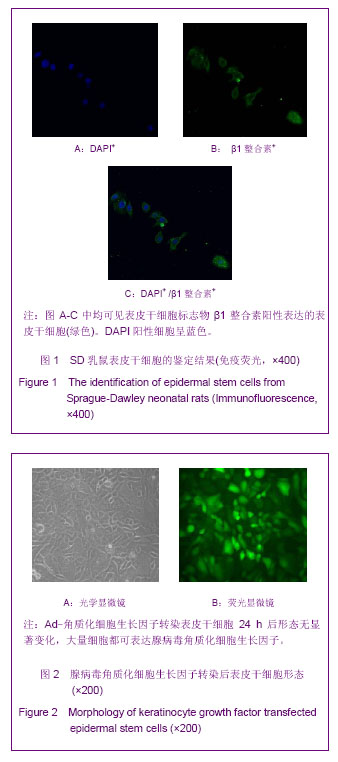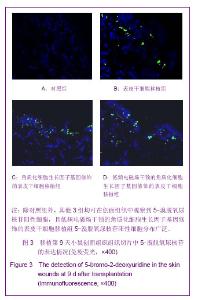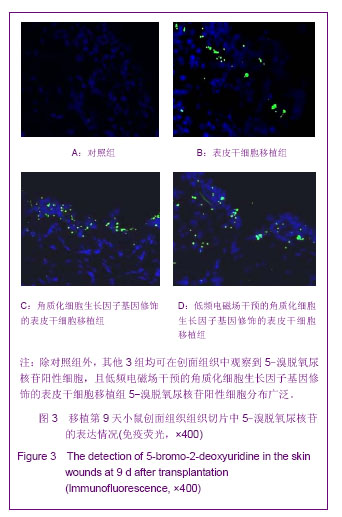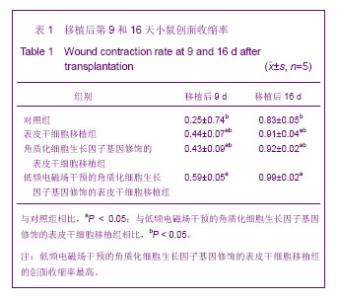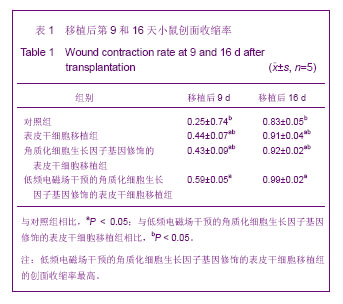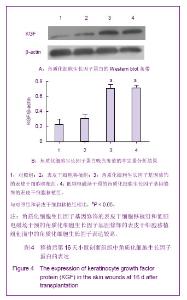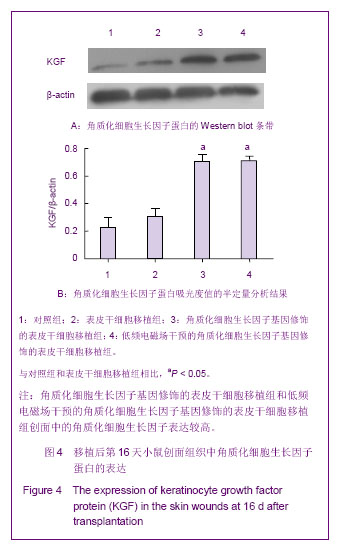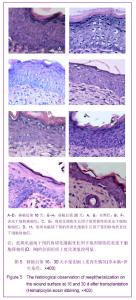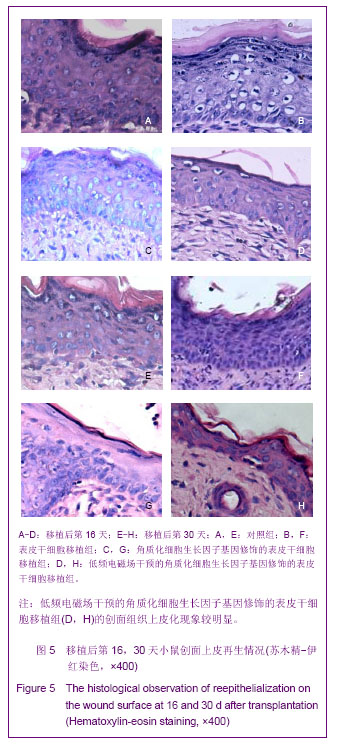| [1] 曾慧平,林国徼,刘颂文,等.烧伤康复及增生性瘢痕处理之科研发展[J].中国康复医学杂志,2010,25(1):89-92.[2] Siddiqui AR, Bernstein JM. Chronic wound infection: facts and controversies. Clin in Dermatol. 2010;28(5):519-526.[3] Mike R, Andreas H, Brigitte NG. Local treatment of chronic wounds in patients with peripheral vascular disease, chronic venous insufficiency, and diabetes. Dtsch Arztebl Int. 2013; 110(3):25-31.[4] Mulder G, Wallin K, Tenenhaus M. Regenerative materials that facilitate wound healing. Clin Plast Surg. 2012;39(3):249-267.[5] Bargues L, Prat M, Leclerc T, Bey E, et al. Present and future of cell therapy in burns. Pathol Biol (Paris). 2011;59(3):e49-56.[6] 吕淑坤.表皮干细胞在组织工程创面修复中的应用[J].中国组织工程研究,2012,16(27):5126-5130.[7] Gharzi A, Reynolds AJ, Jahoda CA, et al. Plasticity of hair follicle dermal cells in wound healing and induction. Exp Dermatol. 2003;12(2):126-136.[8] Costin GE, Birlea SA, Norris DA, et al. Trends in wound repair: cellular and molecular basis of regenerative therapy using electromagnetic fields. Curr Mol Med. 2012;12(1):14-26.[9] Martin P, Parkhurst SM. Parallels between tissue repair and embryo morphogenesis. Development. 2004;131(13):3021- 3034.[10] Lombaert IM, Brunsting JF, Wierenga PK, et al. Keratinocyte growth factor prevents radiation damage to salivary glands by expansion of the stem/progenitor pool. Stem Cells. 2008; 26(10):2595-2601.[11] The Ministry of Science and Technology of the People’s Republic of China. Guidance Suggestions for the Care and Use of Laboratory Animals. 2006-09-30.[12] 李孝建,李延仓,曾耀英,等.鼠表皮干细胞的稳定分选方法及其体外培养体系建立[J].中国组织工程研究与临床康复,2008, 12 (25): 4851-4854.[13] 李新平,白利明,白文芳,等.腺病毒介导的角质化细胞生长因子基因修饰促进表皮干细胞增殖[J].中国临床解剖学杂志,2011, 29(5): 561-564.[14] Robert D, Galiano J, Michael V, et al. Quantitative and reproducible murine model of excisional wound healing. Wound Repair Regen. 2004;12(4):485-492.[15] Gao F, Liu YW, He YQ, et al. Hyaluronan oligosaccharides promote excisional wound healing through enhanced angiogenesis. Matrix Biology. 2010;29(2):107-116.[16] Enestvedt CK, Hosack L, Winn SR, et al. VEGF Gene Therapy augments localized angiogenesis and promotes anastomotic wound healing: a pilot study in a clinically relevant animal model. J Gastrointest Surg. 2008;12(10):1762-1770.[17] Branski LK, Masters OE, Herndon DN, et al. Pre-clinical evaluation of liposomal gene transfer to improve dermal and epidermal regeneration. Gene Ther. 2010;17(6):770-778.[18] Ko J, Jun H, Chung H, et al. Comparison of EGF with VEGF non-viral gene therapy for cutaneous wound healing of streptozotocin diabetic mice. Diabetes Metab J. 2011;35(3): 226-235.[19] Louro J, Pearse DD. Stem and progenitor cell therapies: recent progress for spinal cord injury repair. Neurol Res. 2008;30(1):15-16.[20] Ray P. Protection of epithelial cells by keratinocyte growth factor signaling. Proc Am Thorac Soc. 2005;2(3):221-225.[21] Pereira CT, Herndon DN, Rocker R, et al. Liposomal gene transfer of keratinocyte growth factor improves wound healing by altering growth factor and collagen expression. J Surg Res. 2007;139(2):222-228.[22] Goudarzi I, Hajizadeh S, Salmani ME, et al. Pulsed electromagnetic fields accelerate wound healing in the skin of diabetic rats. Bioelectromagnetics.2010;31(4):318-323.[23] Mattsson MO, Simkóa M. Is there a relation between extremely low frequency magnetic field exposure, inflammation and neurodegenerative diseases? A review of in vivo and in vitro experimental evidence. Toxicology. 2012; 301(1-3):1-12.[24] Tepper OM, Callaghan MJ, Chang EI, et al. Electromagnetic fields increase in vitro and in vivo angiogenesis through endothelial release of FGF-2. FASEB J. 2004;18(11): 1231-1233.[25] 张鸣生,吴博,白文芳,等.低强度电磁场促进鼠表皮干细胞移植修复皮肤缺损的实验研究[J].中华物理医学与康复杂志,2011, 33 (4):250-253.[26] Ongaro A, Pellati A, Masieri FF, et al. Chondroprotective effects of pulsed electromagnetic fields on human cartilage explants. Bioelectromagnetics. 2011;32(7):543-551.[27] Hopper RA, Verhalen JP, Tepper O, et al. Osteoblasts stimulated with pulsed electromagnetic fields increase HUVEC proliferation via a VEGF-A independent mechanism. Bioelectromagnetics. 2009;30(3):189-197.[28] Jonathan NM. Tissue-engineered skin substitutes in regenerative medicine. Curr Opin Biotechnol. 2009; 20(5): 563-567.[29] 沈奕,李海燕.组织工程皮肤的临床研究进展[J].河北医科大学学报,2009,30(6):637-640.[30] 董丽,王旭昇,马绍英,等.组织工程皮肤的构建及组织形态学观察[J].中国组织工程研究与临床康复,2011,15(41):7631-7634. |
